Originally published on Torontoist on February 3, 2017.
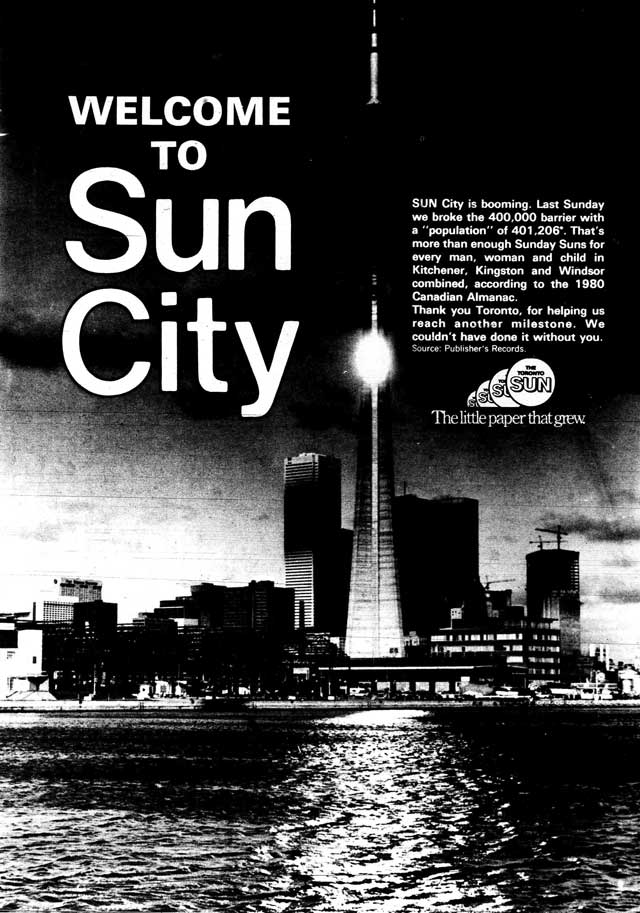
Toronto Sun, November 9, 1980.
In a response to a reader question on Twitter earlier this week provoked by Toronto Sun columnist Tarek Fatah’s comments on the Quebec City mosque shooting, Toronto Star reporter Daniel Dale described the Sun as publishing, beyond a decent sports section and solid tabloid-style news coverage, “the country’s worst opinion writers.” While readers can debate Dale’s use of “worst,” the current crop of Sun columnists continues a long tradition of deliberately provocative writing that has shaped the paper since its inception in 1971.
It’s a tradition that hasn’t always landed on the right side of history. To be fair, flipping through the back pages of any newspaper exhumes opinions which would be questionable today. Skeletons among the Toronto press range from George Brown’s attacks on Irish immigrants during the early days of the Globe to unflattering descriptions of minorities in the Star which matched the prejudices of the day.
But the Sun has always stood out for its unapologetic view of the world, which grew from cockiness as the new kid on the block and its ability to connect with its conservative readership. It played upon fears of outsiders, and earned its stripes as a dedicated Cold Warrior by labeling opponents as evil Communists/Marxists/socialists/bleeding hearts/etc.
During the 1970s and 1980s the Sun’s biases regarding anyone who wasn’t white provoked consternation among minority groups, which nearly caused the City to pull its advertising from the paper. An extensive report by the Urban Alliance on Race Relations published in 1987 pulled few punches in its analysis of the paper’s stances: “The sheer volume of racial stereotypes, racism, scapegoating, and the presence of statements that may elicit fear and hatred against racial minorities can leave little doubt that there is considerable prejudice and racism directed toward non-whites and ethnic minorities within the pages of the paper.”
Reading back issues of the Sun, and certain columnists in particular, can be a depressing experience. Beyond the posturing and vitriol, it’s eye-opening to witness the level of contempt writers express for their fellow human beings.
Here are some historic topics where the Sun’s views didn’t stand the test of time, or remain offensive.
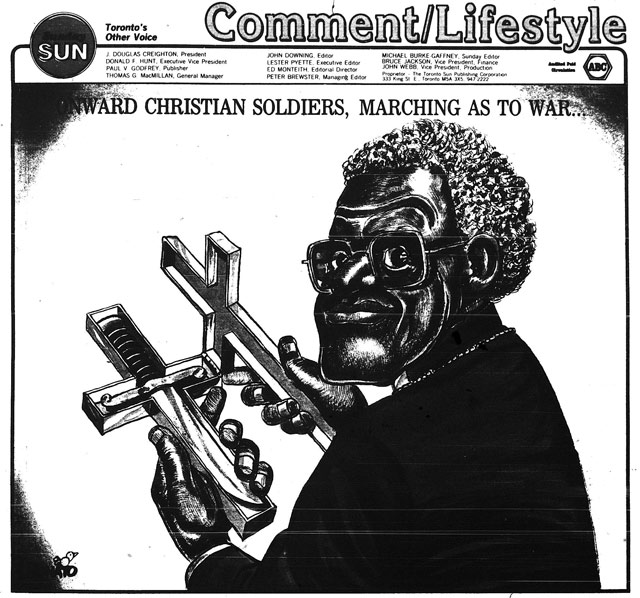
A more enlightened view of Desmond Tutu than some Sun columnists had. Cartoon by Andy Donato, Toronto Sun, June 1, 1986.
South Africa
As the fight against the apartheid regime grew stronger during the 1980s, the Sun was lukewarm on the idea of handing power to the Black majority before they were “ready” to assume control. Given the African National Congress’s ties to Communist organizations, and the track record of post-colonial Africa, Sun editorials conveyed fears that South Africa would become another Marxist hellhole. In the Sun‘s view, all that stood in the way of total chaos were the white Afrikaners. “The hundreds of blacks dying in South Africa are victims of racism, but not by the dominating whites,” a July 1985 editorial observed. “It’s the racism that is the by-product of the class warfare demanded by Marxists and liberals blinded by Marxism.
Barbara Amiel went further, suggesting that progressives couldn’t wait to see a long, bloody war unfold. “The struggle closest to them,” she wrote in August 1985, “actually seems to be their own effort to restrain an unseemly relief that, at last, South Africa might be in for a really good spell of what the rest of the unfortunate people on the African continent have known and are suffering: murder, mayhem and economic disaster.”
Columnist McKenzie Porter all too frequently defended the apartheid regime, seeing it as both the last hope against the Commies and as a benevolent, paternalistic means of looking after the backward Blacks, who “still consult witch doctors and rely on donkey power.” Porter criticized condemnation from the West as springing from “the illusion that all men are equal.”

Toronto Sun, December 22, 1977.
In his July 24, 1985 column, Porter predicted that “if South Africa gave the vote to every black today it would bring about the destruction of the agriculture, industry, and commerce that are essential to the eventual emancipation of the supposedly oppressed majority.” He also thought that South African Blacks were dumber than their North American counterparts, who’d had the benefit of being in white educational systems for generations. “For reasons palpable to every reader of history,” he observed, “the average South African black, clad though he may be in a collar and tie, still embodies some vestiges of a recent Stone Age past.” Finally, he stated that Nobel Peace Prize winner Desmond Tutu was “not very bright.”
That particular column was the final straw for Mayor Art Eggleton and his committee on community and race relations, which had noticed the Sun’s less than admirable stands on race in general. The committee threatened to pull city advertising from the paper, which provoked a heated response from Sun publisher Paul Godfrey. He defended the Sun’s writers on the grounds of freedom of the press, and taunted both the mayor and the committee in print. He also noted Porter had visited South Africa, though it was unclear if the trip had been paid for by the regime. Both sides soon cooled the conversation, with Eggleton suddenly declaring the Sun wasn’t so racist after all (a shift Godfrey, a former Metro Chairman, praised as a sign of the mayor’s conciliatory nature).
When Nelson Mandela toured North America in 1990, the Sun was not wowed by the praise showered upon the recently released icon. There was still suspicion of Communist links, along with the behaviour of Winnie Mandela and her bodyguards while he was imprisoned. As David Frum put it, “myth-making has transformed a man who might otherwise be just another African opposition leader into an international celebrity.”

Comment on John Sewell’s support of Toronto’s gay community during the 1980 municipal election. Cartoon by Andy Donato, Toronto Sun, September 28, 1980.
Homophobia
Let’s be blunt: the Sun was intolerant toward homosexuals during the 1970s and 1980s. From cartoonist Andy Donato’s frequent limp-wristed depictions of gays to editor Peter Worthington’s threat following the 1981 Bathhouse Raids to expose names of anyone rounded up in subsequent police scoops, there was no sympathy to anyone who wasn’t heterosexual.
Perhaps the most homophobic of the lot was Queen’s Park columnist Claire Hoy. In piece after piece, Hoy depicted homosexuals as sad, pathetic creatures. He was convinced that there was an agenda by homosexuals to gain access to classrooms to convert innocent children to their perverted lifestyle. “It is not true that homosexuals want simply to be left alone to do whatever it is they do to each other,” he wrote in January 1978. When a “Gaydays” celebration was held later that year, he wondered why “more Torontonians don’t let them know they’re not welcome here” and when people would “wake up and realize the danger of keeping silent in the face of this creeping, crawling sickness in our society?”

Typical Claire Hoy column headline. Toronto Sun, October 30, 1979.
Hoy used his QP perch to step into the 1980 municipal election, a campaign the Sunhad no shortage of homophobic commentary on in the wake of mayor John Sewell’s support of the community and George Hislop’s council run. Following the Toronto Board of Education’s decision to allow a homosexual liaison committee to talk with students struggling with their own sexual identity, he listed all of the trustees who “voted to give homosexuals a beachhead.” He urged readers to register their indignation at the ballot box lest the radicals (who he referred to as “dingles”) win.
Hoy went on to serve as the paper’s Ottawa columnist and was forced out after writing one too many columns attacking Brian Mulroney for Godfrey’s taste. A subsequent stint at the Ottawa Citizen ended after he continued to attack the queer community.
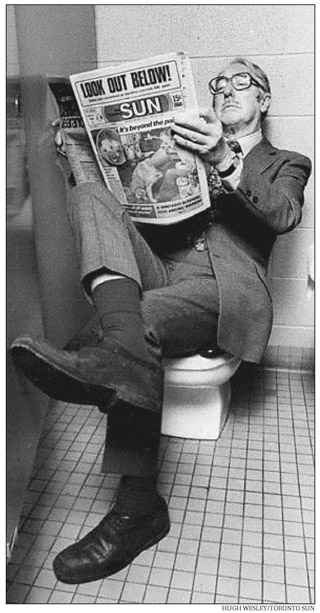
McKenzie Porter on the crapper, a reference to one of his most infamous columns. Globe and Mail, November 2, 1986.
Eugenics
One of the darkest corners of the Sun’s back pages is McKenzie Porter’s ongoing support of eugenics as a solution to society’s ills. While peers commented that his snobbish persona may have been a put-on, his repeated references to sterilization make one wonder how serious he was about other outrageously written columns.
The following excerpt from Porter’s October 25, 1982 column is as chilling an opinion piece as you’ll ever find in a Toronto newspaper. It’s absurd and frightening at the same time.
The only way to rid ourselves of poverty and its related diseases of insanity and crime is by embracing the science of eugenics. This science was held back 100 years because Hitler distorted and pursued its principles in a hideously cruel way. We must remember that Hitler was crazy. We must believe that eugenics may be practiced in a sane and civilized way.
It should not be difficult to persuade genetically unsound indigents to submit them to sterilization if it is pointed out to them that their new condition will permit them unlimited sexual pleasure without bringing upon them the burden of handicapped children. A properly mounted government publicity campaign would result in the submission of the vast majority of unfit people to voluntary sterilization. Some element of compulsion will have to be accepted once the practice of eugenics is adopted. Boards of control manned by doctors, lawyers, psychiatrists, clergymen and others should be empowered to order certain people be sterilized.
Porter further suggests that anyone sent to prison for the second time be sterilized, and that all patients admitted to hospital “should be examined for severe hereditary handicaps.”
He continued to write for the Sun until 1990, by which time a column suggesting that no Canadian citizen born outside of the country should be allowed to vote because of a tendency to indulge in ethnic partisanship prompted city council to pull its ads from the paper.
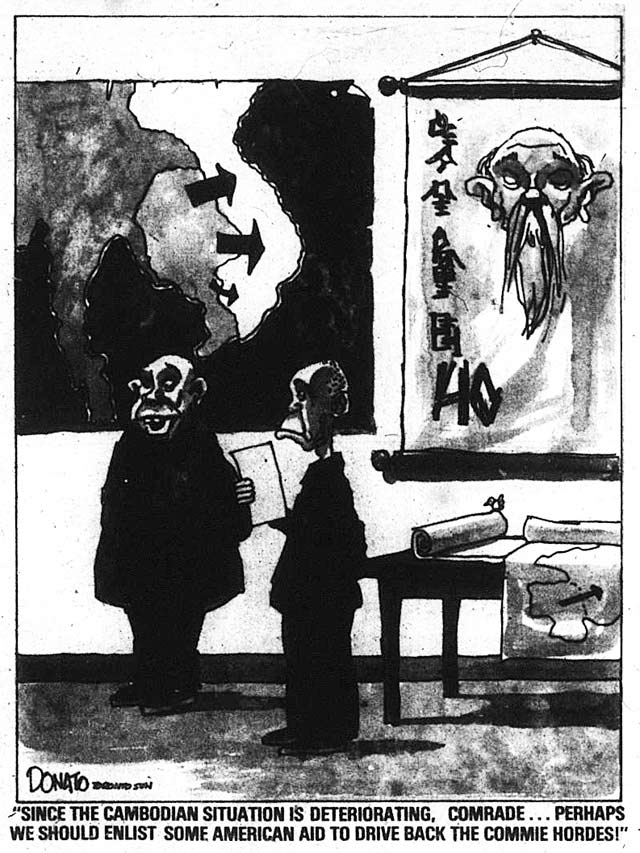
This Andy Donato cartoon, about the situation in southeast Asia, typifies the paper’s view of Communism, and ran next to a pro-Pinochet editorial. Toronto Sun, January 8, 1978.
Augusto Pinochet
The Sun’s hatred of any government with the faintest left-wing tinge had few bounds. The paper’s mad hate-on for Pierre Trudeau became something of a joke. Columnists like Lubor Zink forever warned about the dangers of Communism. While Zink exposed true atrocities committed by such regimes, his zealous fervour also became a joke.
One fight against the left the Sun really misfired on was its support of Augusto Pinochet’s regime in Chile. In a 1978 editorial, Chile’s status as a “whipping boy” nation alongside nations like Rhodesia and South Africa was criticized. “Chile’s great sin is to have violently ousted a Marxist government—a rare occurrence,” the paper noted. The piece went on to note how poor Chile was trying to earn a spot among respectable nations while it undid damage blamed on former president Salvador Allende, and how it was ironic China helped them when Canada didn’t. “It is an obscenity to concentrate on the sins of a minor offender while ignoring sins of a major offender.” To which we say it’s also ultimately a sin to brush aside the thousands who disappeared or were tortured during Pinochet’s regime.
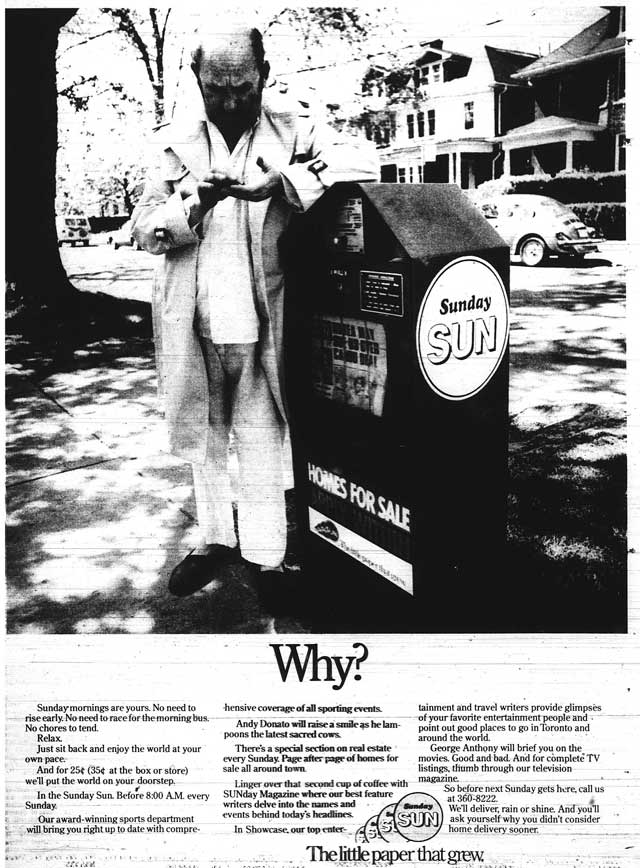
Toronto Sun, September 4, 1977.
After spending years sifting through these opinions, it’s disturbing how there’s been a steady market for this strain of journalism. What really grates, as a study done of depictions of immigration and racism in the Toronto press of the 1970s showed, was that unlike its competitors, the Sun often presented a single worldview, lacking diversity or nuances. Instead of promoting healthy debate around the above issues, or ongoing problems such as community-police relations and where immigrants fit into Canadian society, the Sun frequently promotes divisiveness at the expense of better understanding between people. It’s the easier, more sensational way to go, but it ignores the human cost of such thinking.
Ultimately, future historians will judge whether today’s Sun columnists and editorial writers reflect the beliefs of their readership, have a sense of where the world is heading, or live up to Dale’s criticism of their worth.
Additional material from Power Without Responsibility: The Press We Don’t Deserve by Effie Ginzberg (Toronto: Urban Alliance on Race Relations, 1987); The Little Paper That Grew by Jean Sonmor (Toronto: Toronto Sun, 1993); the October 31, 1985 edition of the Globe and Mail; and the February 4, 1977, January 6, 1978, January 8, 1978, August 25, 1978, September 3, 1980, September 25, 1981, October 25, 1982, July 24, 1985, August 4, 1985, and June 22, 1990 editions of the Toronto Sun.
ADDITIONAL MATERIAL
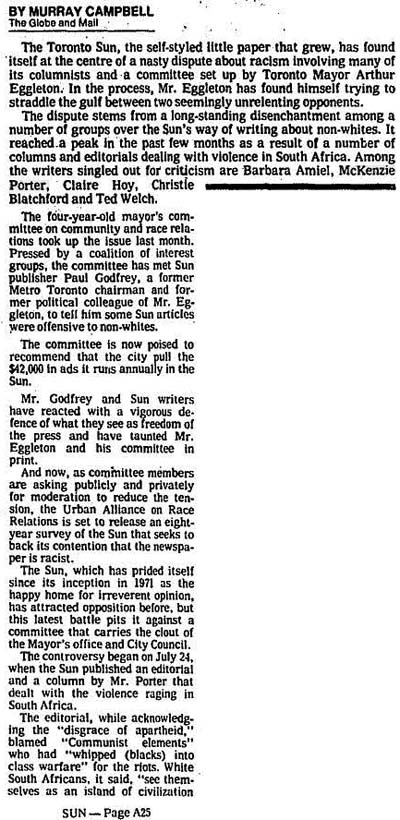

Globe and Mail, October 31, 1985.
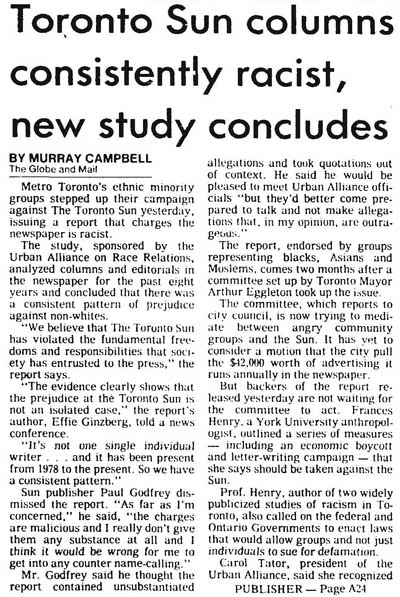

Globe and Mail, December 13, 1985.
The report referred to, Power Without Responsibility: The Press We Don’t Deserve, is worth seeking out. Be prepared to be nauseated by some of the excerpted columns (unless your views align with those of the late 1970s/early 1980s Sun).
Godfrey spent the next two months listening to deputations, then wrote a conciliatory letter to the Urban Alliance. In March 1986, the Ontario Press Council dismissed complaints about Porter’s take on South Africa. “Those meetings went on for four, five, sometimes six hours,” Godfrey later recalled. “But I valued them. I always remember that wars are started by a failure to communicate. So I’d take them into the boardroom, give them muffins and coffee and invite them to tell me why they were unhappy with the Sun.”
I suspect present-day Sun management would throw the muffins and coffee at complainants.

Toronto Sun, February 6, 1989.
While this story didn’t make the final cut, it’s worth bringing it up within the context of the other issues discussed in my piece. This column proved the final straw when it came to McKenzie Porter writing provocatively outrageous things: suggesting that anyone born outside of Canada should be prevented from voting or running for office.

Toronto Star, February 26, 1989. Note that the wrong date was provided for the offending column.

Toronto Star, March 3, 1989.
The city’s ad ban lasted two months, before reconsidering after being accused of censorship. Porter was criticized in the Ontario Legislature for the column, and retired from the Sun the following year.

Toronto Sun, November 13, 1977.
For contextual purposes, here is a typical example of a Claire Hoy column dripping with homophobia. The vitriol in his pieces, which ostensibly were supposed to cover goings-on at Queen’s Park but often degenerated into rants against people Hoy hated, is thick. The language is dehumanizing, referring to his opponents not as people but “creatures.” And yet it is not difficult to imagine these words being used in 2018 in discussions over Ontario’s sex education curriculum.

Toronto Sun, January 8, 1978.
The pro-Pinochet editorial I referred to. Not unusual during the Cold War era but, given what we now know about the aftermath of Pinochet’s coup in 1973, an editorial that has not aged well.
BEHIND THE SCENES
This was my last non-Historicist piece published by Torontoist, though it could have easily fit within that column. It was a parting gift to outgoing EIC David Hains, who had suggested for some time that I write a piece on the past transgression of the “Little Paper that Grew.” Two more Historicist columns, and a look back at my time writing that particular column, would mark the end of my decade-long run at Torontoist.
I was first exposed to the Sun when my father picked up copies of the paper during m childhood trips to Toronto. It was the first tabloid-sized paper I was exposed to, and I loved the comic book format of the weekend funnies. Those papers made it into my father’s giant clipping collection–I recall photocopies of Douglas Fisher columns explaining the mechanics of parliament being passed around in the grade 9 history class Dad taught.
In university during the mid-1990s, I occasionally bought the Sunday Sun, partly as a joke, partly as a chance to see what the right side of the spectrum was saying, and partly for the Sunday funnies to hang on my dorm room. Two things brought this to an end: the incessant attacks against teachers and other public professionals, and a landlord who cheered on the paper’s taunts. While I have flipped through copies of the paper lying around, I have not paid for one since the end of the 20th century.
Its current incarnation is little more than a vehicle for populist outrage, reconfirming the biases of its readers instead of trying to broaden them, stoking divisions that aren’t necessary and do more harm than good. I ignore it and its writers as much as possible, since I can probably predict from a headline whatever the copy will read.